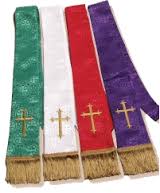Liturgical Colors of the Church Year
 Colors play an important part of the worship of the Church and they change according to the seasons of the Church year. Colors are a primary source of symbolism, and tell us much about what we believe about the lessons we hear during the Liturgy of the Word (which are themed according to the seasons), and about what we do during worship.
Colors play an important part of the worship of the Church and they change according to the seasons of the Church year. Colors are a primary source of symbolism, and tell us much about what we believe about the lessons we hear during the Liturgy of the Word (which are themed according to the seasons), and about what we do during worship.
There are five basic liturgical colors: Purple, White, Green, Red, and Black.
Purple – Advent & Lent
Purple is the color of royalty and the color of humility, penance, and wisdom that comes from inward discernment. Also, purple was used by churches that followed the Roman rite as opposed to the Sarum Rite. These are all adjectives which describe the season of Advent.
Purple is also the color of royalty. The extreme differences between the two (humility and royalty) express one of the great lessons of Lent: Christ as the servant-king and our endurance to be as such to the world as well. In penitential theology, purple is the color of inward reflection, which is one of the important things we are called to do each Lent in preparation for Easter.
White – Christmas, Easter, Baptisms,
Weddings & Funerals
White is the color of both Easter and Christmas. It is the color of celebration, joy, and peace in the western world. White symbolizes the greatest work of God in the world, specifically His incarnation into this world at Christmas, and His triumph over death and evil at Easter. White is the color used for funerals, as we celebrate the passage of another soul into the Kingdom of God. Likewise, it is the color of baptisms and weddings, as we celebrate the arrival of another child of God into his household of faith, and as we celebrate the union of soul mates into one family in the eyes of God.
Green – Epiphany & Trinity
Green is the color of revelatory experience, and so is the color of the feasts that celebrate God’s revelation to mankind: Epiphany and Trinity. Epiphany, the season after Christmas, celebrates Christ’s revelation as the Incarnate God to the Gentiles, while Trinity celebrates the revelation of the One Eternal God as revealed in the persons of the Father, Son, and Holy Spirit. The season after Trinity falls within the late Spring and Summer months, when we see the natural world grow green with leaves, vines, and crops. Therefore, green symbolizes our own spiritual growth in Christ, nurtured by the Church and the Gospels.
Red – Pentecost, Palm Sunday, Holy Week, & Saints Days
Red is the color of excitement, energy, power, and all things intense and passionate. As such, red is the color of the Holy Spirit. It calls to mind the flames that descended upon the Church at the Day of Pentecost, and so is the color of the Feast of Pentecost. It is also used on Palm Sunday and during Holy Week, recalling the work of the Holy Spirit at Jesus’ triumphal entry into Jerusalem and His Passion. Red is the color of the Holy Order of Bishops, and so is used for all Episcopal visitations and offices (consecrations, ordinations, and confirmations), using a bright, primary red. Finally, red is used for the commemoration of all martyred saints. Red recalls the blood shed for the Faith and the Church during the commemoration of the saints.
Black – Good Friday
Black is generally used on only one day of the year: Good Friday. It is the color of extreme, deep sorrow. Good Friday is the only day of the year that such sorrow is expressed in the Church. Black is appropriate for the first of only two days of the year on which the celebration of the Holy Eucharist is forbidden. On Good Friday, the altar is usually kept stripped. However, if Communion is to be received from the reserved Sacrament (there is never the celebration of the Eucharist on either Good Friday or Holy Saturday), the altar may be adorned in hangings with black. Since Communion is never received – even from the Reserve – on Holy Saturday, the altar remains stripped with no hangings at all. Should an individual community decide to keep black hangings on the altar during Holy Saturday, they should be removed by sundown, which is the beginning of the Easter Vigil. (Note: Black is not appropriate for Christian funerals, as Christian funeral rites are Easter liturgies – and so white is more appropriately used).